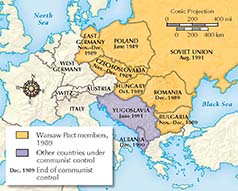CHAPTER 32: Quick Study Guide
Progress Monitoring Online
For: Self-test with vocabulary practice
Web Code: nea-1908
- Key Policies and Actions of Ronald Reagan
Domestic Supported tax cuts and deregulation to stimulate demand under the theory of supply-side economics Took a strong stance on air-traffic controllers’ strike Appointed conservative Justices to the Supreme Court Reformed Social Security Increased defense spending Foreign Pressured the Soviet Union by building up the American military, including the Strategic Defense Initiative program Aided anticommunist forces in several countries, including Afghanistan and Grenada Signed arms control agreements with Soviet leader Mikhail Gorbachev Sent peacekeeping force to Lebanon Ordered an air raid on Libya because of Libyan leader Muammar al-Qaddafi’s involvement in terrorist attacks - Key Events in George H.W. Bush’s Presidency
- Signed Americans With Disabilities Act into law
- Forged friendly relationship between the United States and the new Russian Federation
- Continued the war on drugs by invading Panama and arresting Panamanian dictator Manuel Noriega on drug-trafficking charges
- Sent humanitarian mission to Somalia
- Headed an international coalition of forces in the Persian Gulf War
- The Fall of Communism in Eastern Europe and the Soviet Union
 Quick Study Timeline
Quick Study Timeline
For: Interactive timeline
Web Code: nep-1909






